Expressing Happiness in Art
This week, we look under ice and talk about expressing happiness!
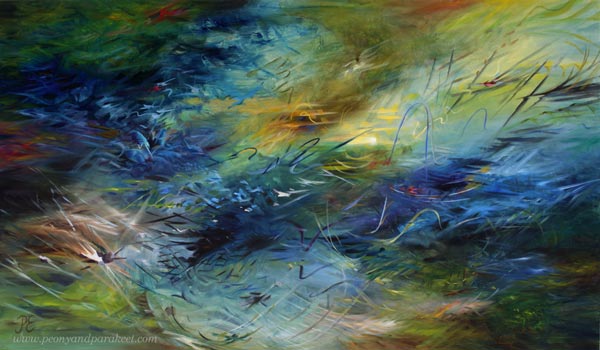
What’s in the Name?
Here’s one of my latest paintings called Onnellisten maa. Like so many times before, I had difficulties translating it, but I came to a conclusion that the English name can be a bit different “Happy Earth” instead of “The Land of Happy Ones.” Maa is both earth and land in Finnish.
This painting is a part of my series Linnunrata – Milky Way, where I explore planets and outer space. The painting represents the planet Earth and Finland, my home country. (See previous paintings: Venus here and the Sun here!)
The name Linnunrata also has a double meaning in Finnish. It’s not only the name of our galaxy but also means bird’s route or track. My paintings often have bird-like shapes and flying objects, so it’s a perfect name for the series and for the upcoming exhibition that will also have some older pieces.
Inspired by Ice
Here’s how the painting started – lots of wild strokes in icy greens.
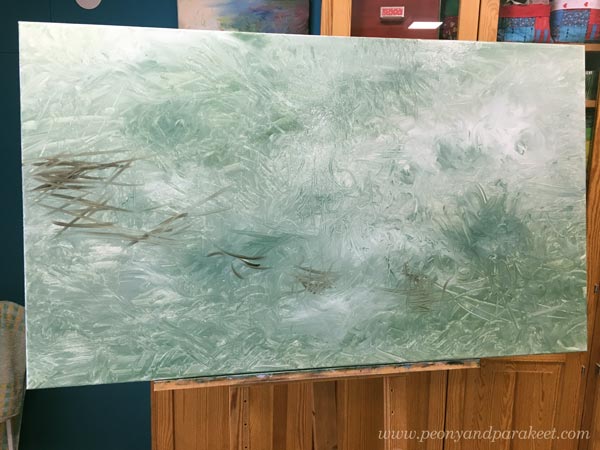
These greens are composed of Titanium White, Raw Umber, and Nicosia Green Earth. The green is a new color that I purchased recently. It’s earthy, not bright at all, but wonderfully suitable for an intuitive painting inspired by our globe.
I also wanted to throw in some blue. At the beginning of April, thin ice covered all the puddles and reflected the sky.
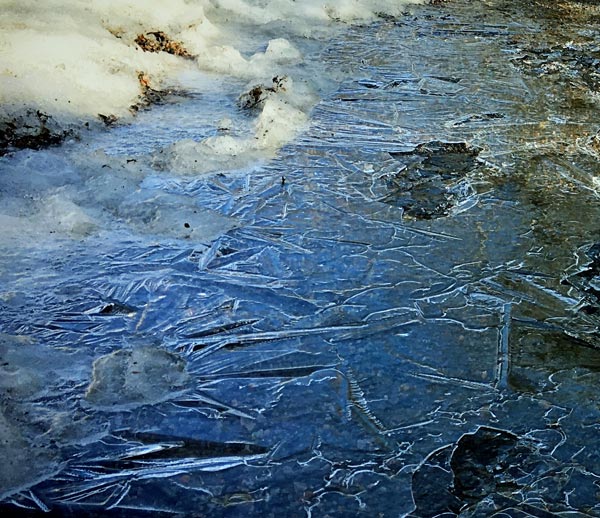
Here’s how the painting looked after adding some Prussian Blue over the greens.
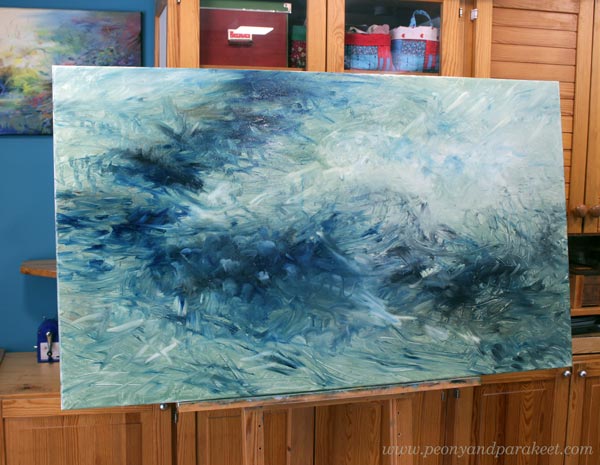
My puppy Saima found ice interesting too!
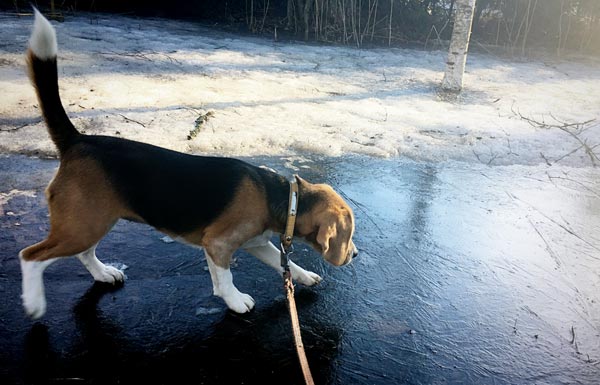
We in Finland are known for icy surfaces, not only in nature but in people too. Our most known celebrity must be a winning formula driver Kimi Räikkönen, also known as The Iceman. “Shut up, let me drive” was his regular message to the team when he was in the middle of the race.
But ice is never only ice. It makes us think about what’s under it. How does Räikkönen feel when he turns the wheel and pushes the pedals – pressure, joy, passion? What is the storm inside an icy person?
Expressing Happiness
Despite all the ice, Finland has been selected as the happiest country in the world again. It’s the fifth time in a row! With the painting, I wanted to tell what makes Finland the happiest. At the same time, I wanted to express what makes the planet Earth so special.
So, it was time to break the ice and bring in more colors.
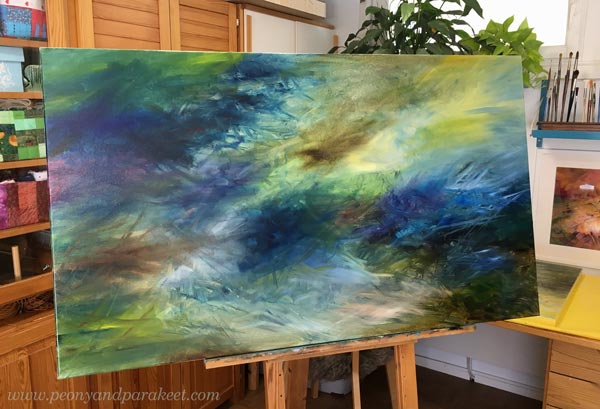
The best feeling when creating art is freedom. We are free to express and discover.
When expressing happiness, seek signs of life. For example:
- Could that spot move if I poke it with a line?
- Could those two lines be connected and thus get wings?
And when a creature is born, let him live in peace! Don’t force him to look like a certain species, but let him be unique in his world. I often aim for the impression of an uncharted area where a human, the viewer, enters for the first time.

I also try to express impact so that the painting makes sense. So, make the movement in one corner cause something else to change. And when you introduce a new color, do it gradually so that it doesn’t only flourish. There should be a beginning and an end to its path.

These two needs are not only what a painting or a drawing hopes to have. They are also important for humans. We want to feel independent and free and still impactful and connected so that life moves forward. I think Finland has been successful in both.
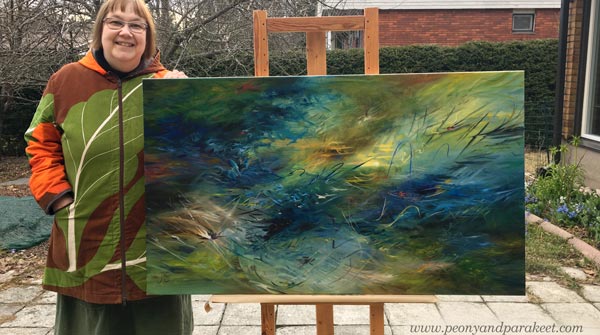
Now, most ice has melted, and our spring has started. Some say that Finnish people change when the summer comes. They see us stop to look at the sun and even smile sometimes!
Painting and teaching are my ways to express happiness.
How have you spread happiness through art?
How to Freely Express Sunshine
This week is about the sun! Let’s dive deeper into how to express sunshine when you want to create freely without reference photos. My example is an oil painting, but you can apply the tips to any supplies.
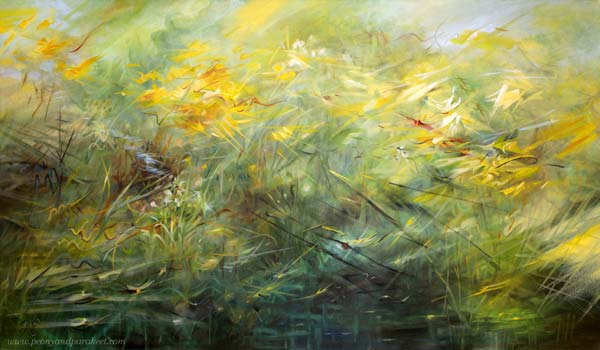
Here’s my newest painting that begins the new series where I explore the stars and planets of the Milky Way. The subject of the first one is, of course, the sun! I named the painting “Runaway Sun” – “Karannut aurinko” in Finnish because I wanted to express sunshine in a dynamic way.
Closed or Open?
Often we paint or draw the sun as a static yellow spot in the blue sky, but I feel that the sun is different. It’s not a closed circle but a very open one. It’s radiating and moving, making things appear and disappear.
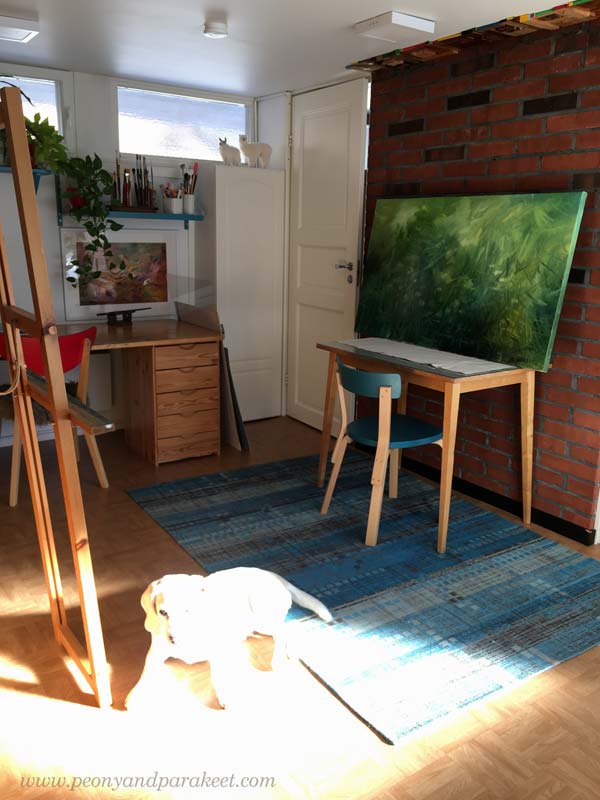
The painting was only a green mess when I took the picture above. “Oh no, the photo of Stella failed badly!” I thought when looking at it. But then, bad photos are the best. They challenge us to see what the world really looks like. Here, the sun has swallowed Stella and entered the room like a giant animal, so it’s not a little closed spot at all.
Isolated or Impactful?
The sun is the star, and the earth belongs to its solar system. The earth could be seen as a toy and the sun as the one who plays the game.
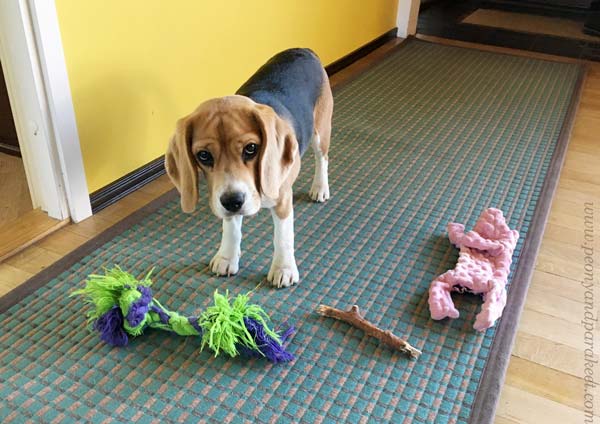
But in our art, the sun often has very little effect on its surroundings. We isolate the sun and keep it far away. For example like this:
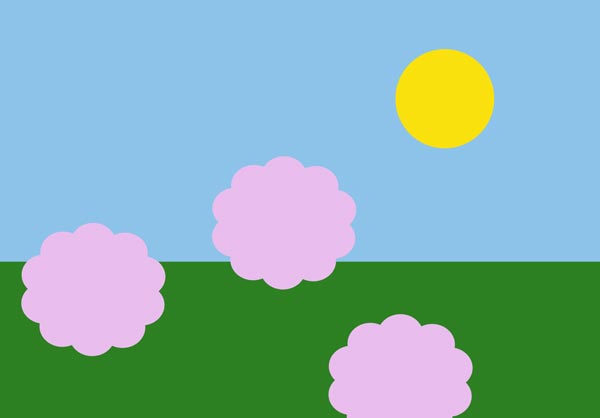
But the sun impacts everything. It travels in the scenery like a runaway that goes here and there, but it’s impossible to catch as a single being.
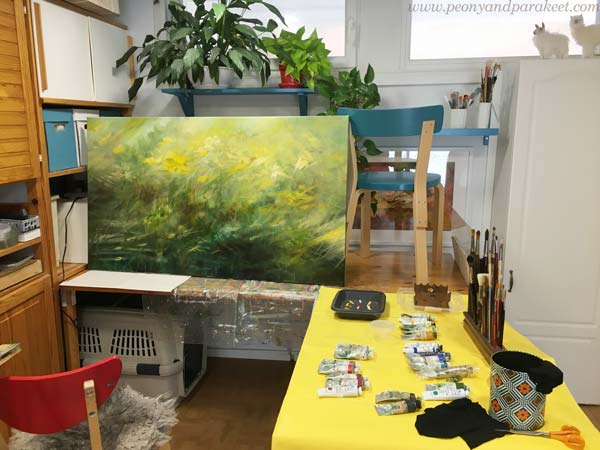
When my painting progressed, it got strong differences between light and darkness. The sunny look requires shadows too!
Is the Sun a Thing or a Person?
Art is only a technical skill as long as you think about drawing or painting things. But if you treat the elements as living beings of some kind, the game changes. When your paper or canvas is filled with people or animals, not just shapes or flowers, everything gets more exciting and it’s easier to express sunshine too.
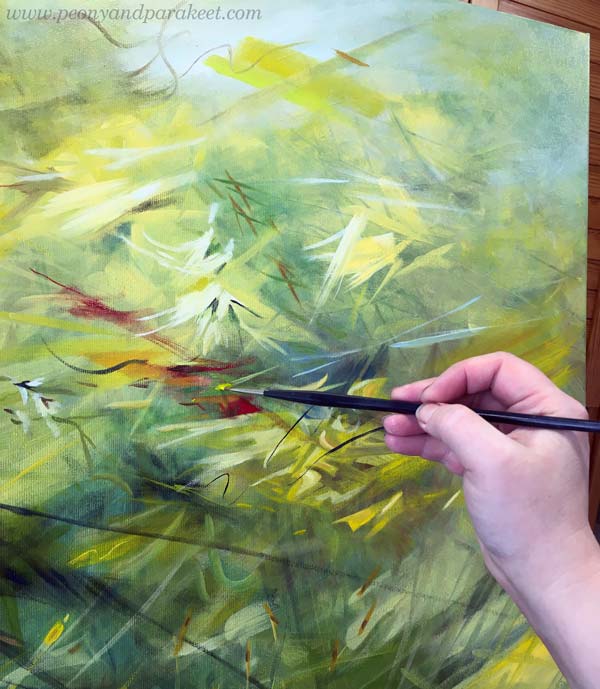
So, ask: Who is this person called Sun? How does she impact everybody in this piece?
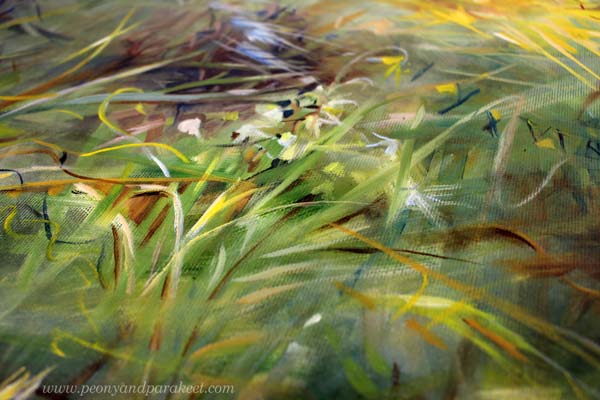
Some will love it, and some will escape from it.
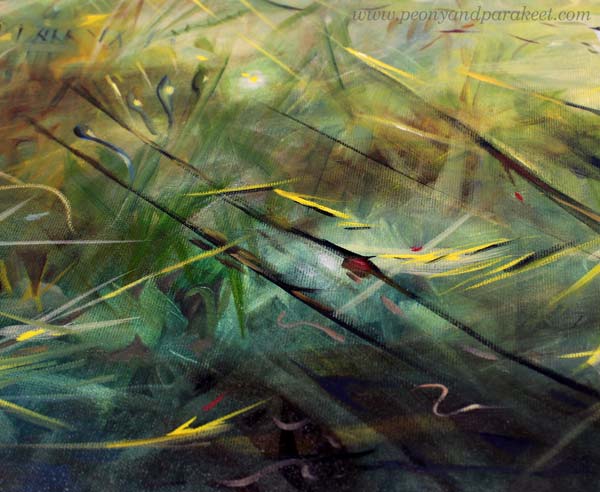
Yellow or White Sunshine?
Some people get any yellow for the sun, and some select their yellow carefully. But I think that one yellow is never enough, and without white, the sun doesn’t shine.
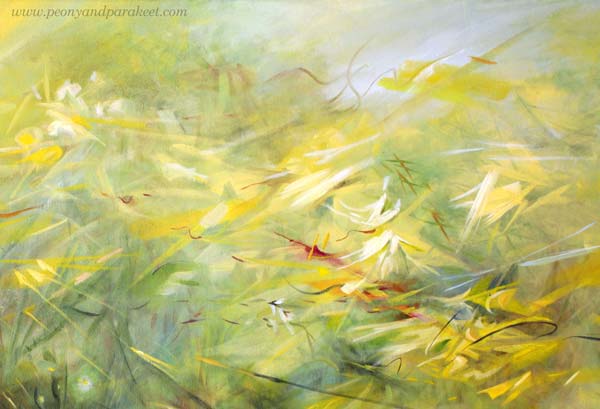
I usually work with a limited set of colors, but I change the tubes every session. So, if I use Indian Yellow in one session, for example, I switch to Lemon Yellow in the next. I do the same for other colors as well. When I create new color mixes from different base colors, my paintings will get a huge variety of tones and look more natural.
I try to always mix some color to most whites so that the variety of pastel tones is present too.
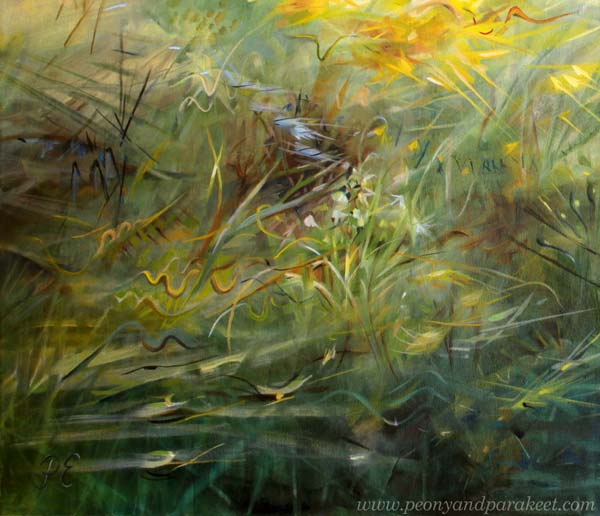
I also add color to blacks or make my own blacks. Browns and blues make wonderful darks!
Does It Express Sunshine? Test!
I like to do a test for all my paintings where I lay them on the table, walk away from the room, and then get back.
I wrote about the test in this blog post too.
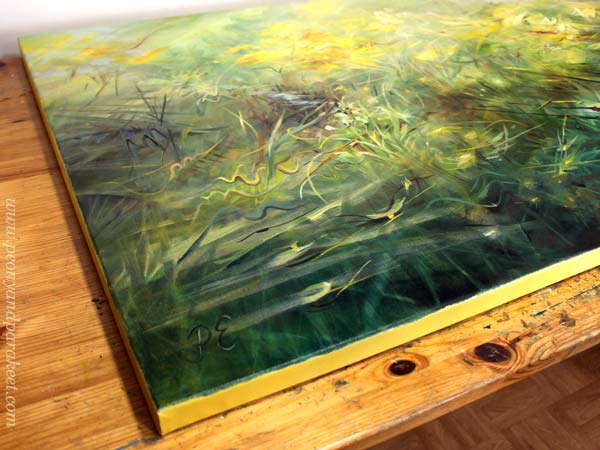
By resetting my mind, I try to get an immediate impact of how the painting affects the surroundings and whether it’s captivating enough. The sunny painting should draw attention and warm the room.
Here’s my little studio one night with other paintings that are still in progress.
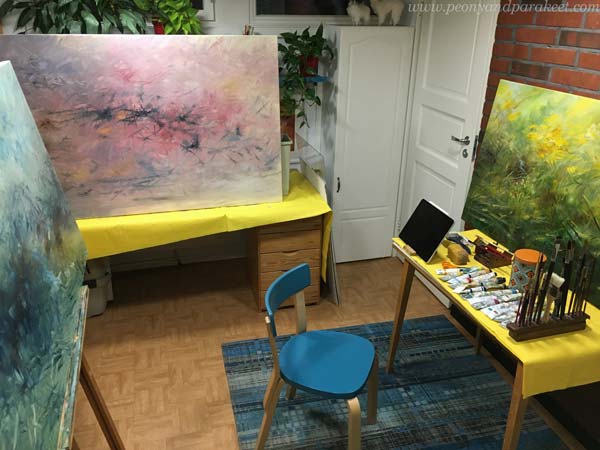
The paintings are too big for my little studio, but I have decided to manage!
Sunshine to Your Weekend!
I hope this post inspired you to bring more sunshine to your art!
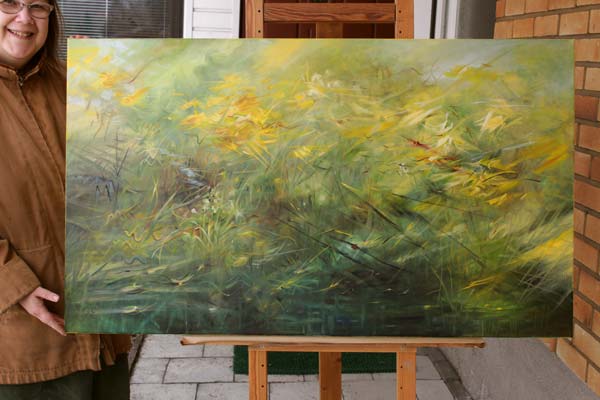
Happy Easter!
What to Paint on Canvas?
This week, I invite you to think about what you should paint. It’s a general question and applies to any medium, but if you have purchased a canvas, the pressure is even higher. My story starts with dogs, and even if they don’t seem to match with the painting, they do. Read the story!
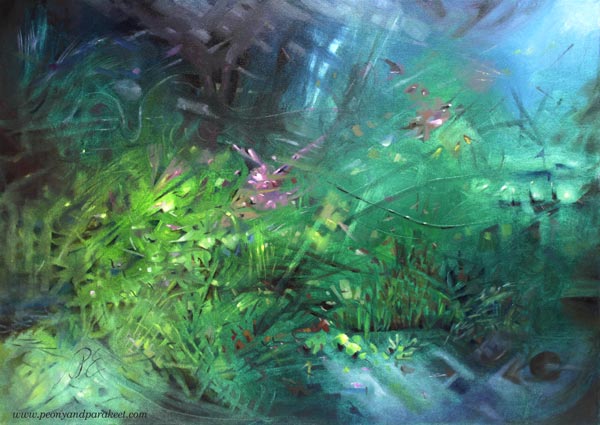
Childhood Without Dog of My Own
If I had to choose one thing that dominated my childhood, it would be the yearning for a dog. When my sister was pushing me in a stroller, I was pointing and screaming “hauva,” which a Finnish word for “doggie.” “How could you instantly recognize a dog from any other animal no matter how it looked,” she wondered.
My father was a policeman, and he had trained two german shepherds a long time before I was born. But a family photo album had a few photos. “Jumi,” was the name of the more handsome one, and I must have drawn him hundreds of times with a trembling hand of a toddler. I pictured the dog standing on the top of the mountain in a sunset. It was an exotic view because there weren’t any mountains in the countryside of eastern Finland. I only saw them if I kneed down, looked up, and stretched my imagination.
Walking in Nature with Imagination
My envy and admiration for all people who had dogs grew steadily, and at the age of five, I had several that were in constant observation. One of them was Kaisa, a vet whose mother lived in a big apartment building next to our house. She had a Finnish spitz and sometimes kindly invited the children of the neighborhood for a forest walk. We were a small and noisy crowd. Everyone had their turn to hold the leash, and even if it was only a few minutes, I still remember how powerful I felt.
So even as a young teenager, I imagined dogs around me whenever I went for a walk. The boring life in a small town became much more bearable when I didn’t have to look around, but only to a close distance. There they were, two brown labrador retrievers that behaved exceptionally well no matter where I took them.
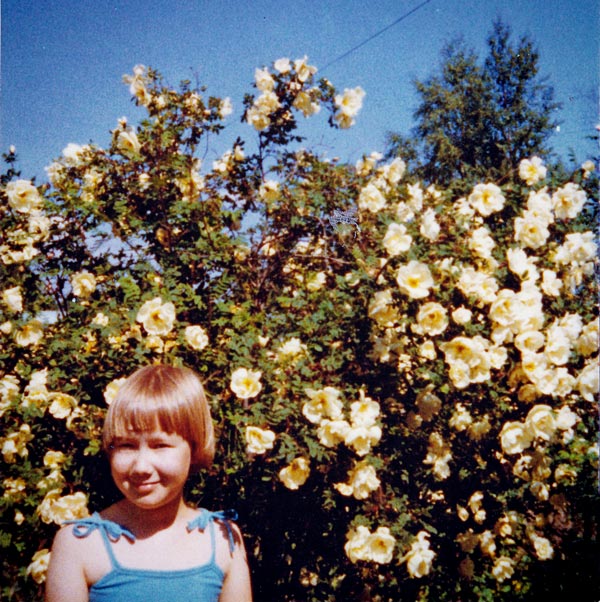
I preferred labradors because the royal family of England bred them. I had always wanted to be the queen of England, so my labradors certainly originated from Sandringham. My friend Anne had got a hold of a catalog of the Crufts dog show, and I excitedly picked the parents for mine. Every time I drew or knitted a dog, I tried to invent the best kennel name for me. “Starway’s” was one of my favorites. By then, my sister had married a man who had a spaniel, and from the spaniel club magazines, I found a new favorite breed: an American cocker spaniel.
Goodbye, Boredom!
The older I got, the more evident it became that I would leave my home town. Instead of frustratedly strolling in the fields and woods of the east, I would be happily hurrying on the busy streets of the south. And not alone, but with an American cocker spaniel of my own!
I would gladly say goodbye to lazy hot summer days when there was nothing else to do than examine the tussocks. When I once pointed them to my mother, she quietly said that our grass wasn’t proper like the apartment building had. But I found it much better. Instead of staring at individual blades, my imagination made wonders from the tussocks. They were luxurious carpets, cushions, and chairs, and when they looked up, I greeted them back. My grass tussocks were like dogs who had them – a flock that was always around and willing to join whatever I did.
When I got my first dog, I was already living in the south. It was an American cocker spaniel, of course. I lived in a flat, but between high buildings, there was a small wood. Unlike me, Anja had been born in an urban environment, and everything in nature wondered her. When she jumped back in surprise after seeing an ant, I realized that I was a country girl – no matter how much I loved palaces!
My next dogs have been beagles. With them, I am back in the world where looking down and examining closely is highly appreciated. Tussocks, hays, wildflowers, and brooks have returned.
What to Paint on Canvas?
In my artistic path from childhood to this day, I have thought that I should create the luxury that I don’t have. That my creativity is at its best when it produces what I miss. But in 2020, when the world quieted down, humble tussocks saw their moment. “Stop haunting me, you don’t even have a voice,” I whispered to them. “We have – and you used to listen, remember?” they responded.
And yes, when I pick the brush, I hear them again. Instead of trying to master the visual state of what I know very little of, I am painting the sounds in the deep. All that time when I wanted to be the queen of Sandringham labradors, I was, and I still am – a herder of mixed-breed tussocks!
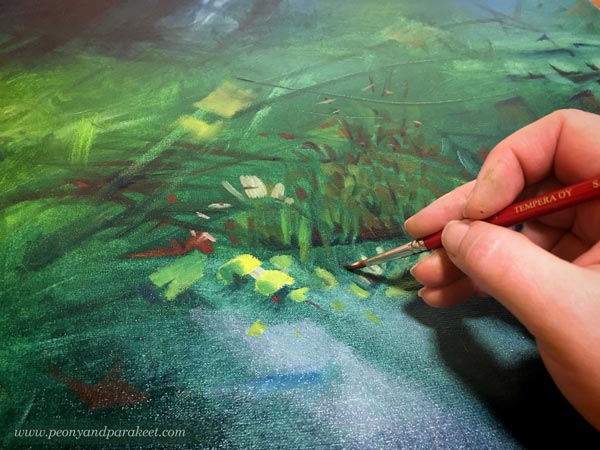
How about You – What Should You Paint?
What you need to paint is not what you want to get and be, but what you have always got and been. The solution is not to find and paint what you love but to look in the opposite direction, find what’s been the most ordinary for you, even if it wouldn’t be that for others. The solution is not to paint how things look, but how they sound, smell, taste, and feel. In the book Point and Line to Plane, Wassily Kandinsky talks about releasing the inner sound of a shape.
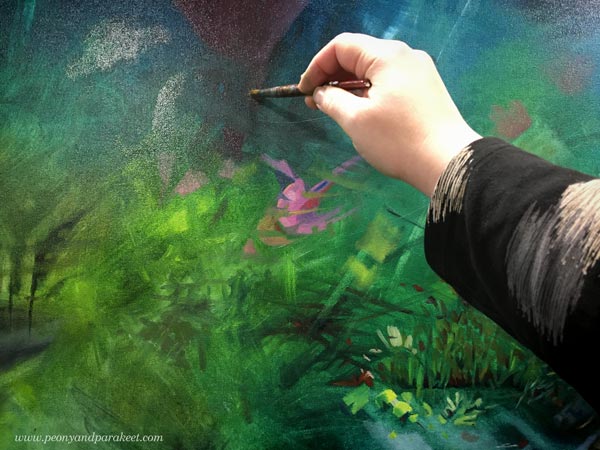
With the tussocks, the teachings of the abstract masters Paul Klee and Wassily Kandinsky have been groundbreaking to me. They have enabled me to paint more freely than ever and I have also built a class Floral Freedom from these teachings. Floral Freedom is especially for you, who wants the painting to look loose and naturally abstract, but who hasn’t find satisfactory results from “just making a mess.”
Good Accidents – When to Improvise
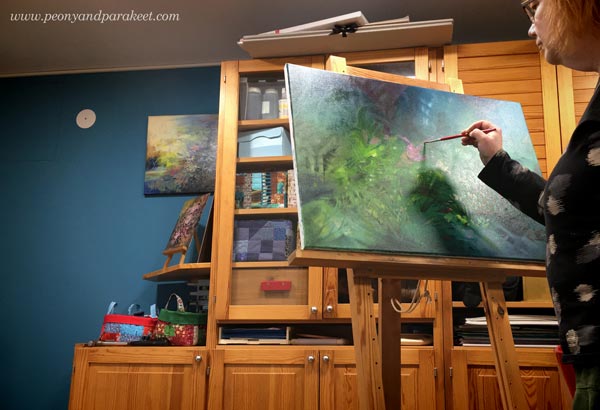
Art is never about just making a mess. Artists who say so are just unable to put it into words. Wassily Kandinsky and Paul Klee were not only exceptional painters but also exceptional teachers. They defined abstract art in methods and diagrams. In Floral Freedom, you get their theories in an easily understandable form and use them to paint flowers.
In this video (after the first two minutes), Helen Mirren talks about Wassily Kandinsky’s art. She first assumed Kandinsky’s work was just improvisation – “instinctive and improvisational and wild and of the moment,” but later learned that his work is constructed with care and thought.
Here’s how she says this:
I can also relate to what Helen Mirren says about acting – that you have to give the impression of the improvisation and naturalness and learn what’s a good accident. But I also have the definition of a good accident in visual art: it’s what you have used to see and know.
I feel that I know everything about the soul of grass tussocks. When I paint them, I don’t have to worry about people not liking them, not even if someone can paint them better. This grass is not any grass but how a 5-year old Paivi saw it, walked on it, and what she imagined from it.
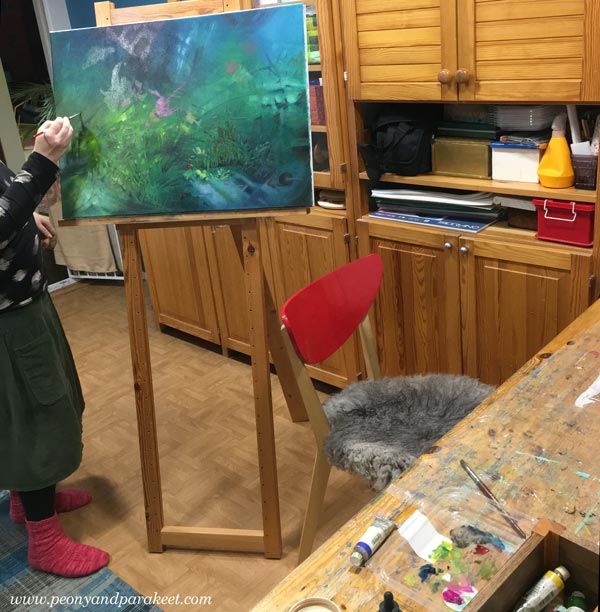
I paint sounds of plants as I hear them, freely and without references. I don’t plan what to paint on a canvas, and I don’t follow any image of my mind. It feels like improvisation, but the process is technical and systematic. One shape follows another and I dive deep into the painting, creating and releasing tensions.
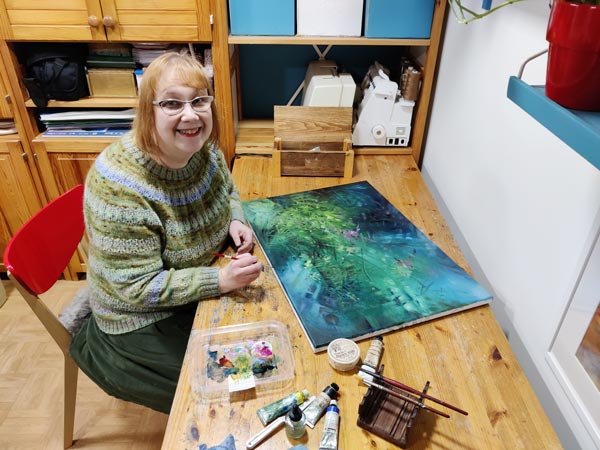
I am filled with excitement and emotion, but work systematically and intentionally, translating from spiritual to visual.

I really enjoyed painting this one – the first one of the new year! It’s called “Syvällä soi” which is a bit difficult to translate in English but it means that some are playing instruments or singing in the deep so the translation could be “Sounds in the Deep.”
Floral Freedom – Paint Dreamy Florals to Free Your Spirit
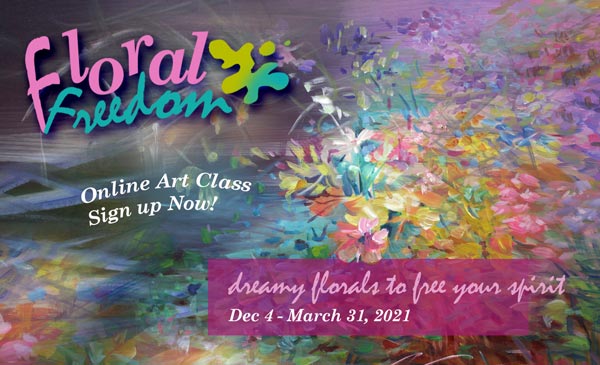
Come to learn the theories behind abstract art, and paint flowers with me – Sign up for Floral Freedom! We use acrylic paints for the projects. The class has already started, but you can still hop in. You will get the published lessons right away, and you have plenty of time to catch up and connect with me and the community. This class is comprehensive, and suitable for self-study too. Sign up now!
No Creative Blocks – Painting Grief and Loss
Even if I want these blog posts to be a celebration of art-making, I also want to paint and write from the heart. This week’s post is about sadness and its’ effects on creativity.

Here’s my latest acrylic painting called “If Grief Smoked.” Like many of the recent paintings, this also has a connection to a poem. The title is from Eeva-Liisa Manner’s poem “Jos suru savuaisi.” But this time, I didn’t follow the poem but used the title as a prompt only.
Missing Cosmo
I have been very melancholic this fall, and to be honest, building a new class Floral Freedom, has been my savior. It’s been a captivating escape from a life that feels emptier than before. My loyal companion Cosmo died in September, and it’s like a part of me has lost a purpose.
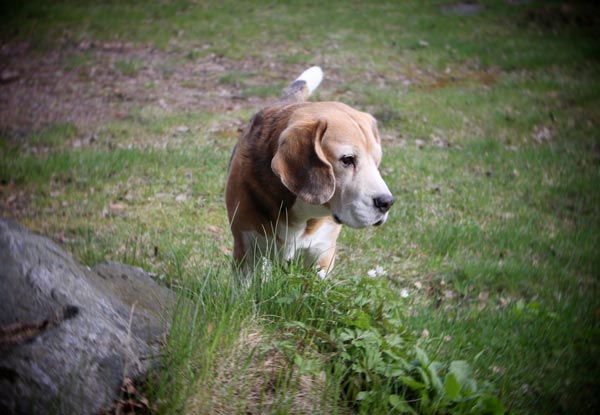
Cosmo was our family member for over 15 years, and there’s a lot I miss about him. Small things, often quite insignificant ones, like how he used to pick a sock when he wanted attention. My heart breaks when I remember how softly he did that, not leaving a single mark. In the end, he was a good dog and didn’t want to behave badly.
So yes, my grief has been smoking and burning. A wind of time has taken some away but also spread it further. When it started to feel that the grief would scorch my brushes, destroy the paints, and make the studio a smoky place, I knew it was time to paint. Not that it would take the grief away, but force me to deal with it.
Persuasion Can Replace Inspiration
Art is not always about inspiration. You know Picasso’s saying that the inspiration has to find you working. I find self-persuasion especially useful. “After this, you can paint whatever you want,” I said to myself.
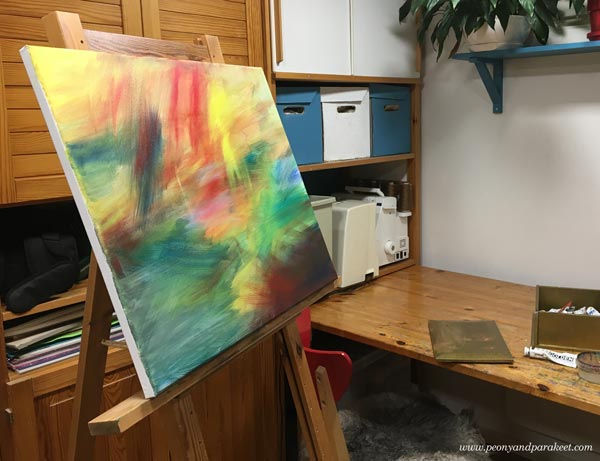
If we don’t paint these paintings that need to come out, it can cause a creative block. I have had some major ones in the past, and I didn’t want that to happen now.

“Follow the color,” I said to myself like many times before. It’s a quote of my own that boosts my confidence when I am working.
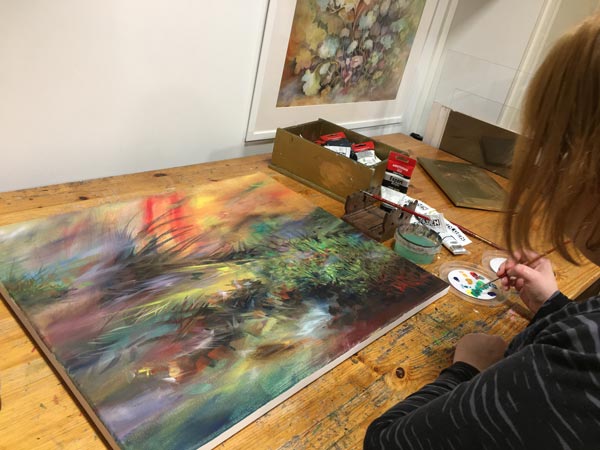
Stepping Into The Painting
This scenery had been in my mind for weeks. It was like an overdue baby, pushing through the brush.
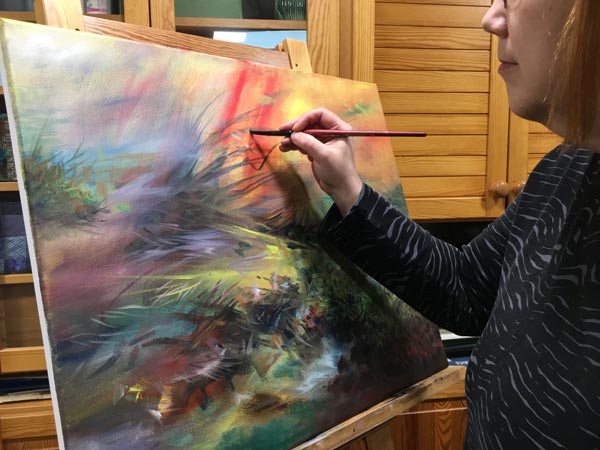
I just had to open my heart and welcome it.
Wassily Kandinsky talks about a glass between the artist and the painting, and how to remove it. It’s one of the hardest things when in grief, but also the most impactful one.

When we paint without the glass, the image becomes more personal. It doesn’t matter what other people think about it because you are living and breathing it. But oddly so, removing the glass also makes the image more general. My loss gets connected to everybody else’s losses. We are all behind the same glass, under the same blanket.
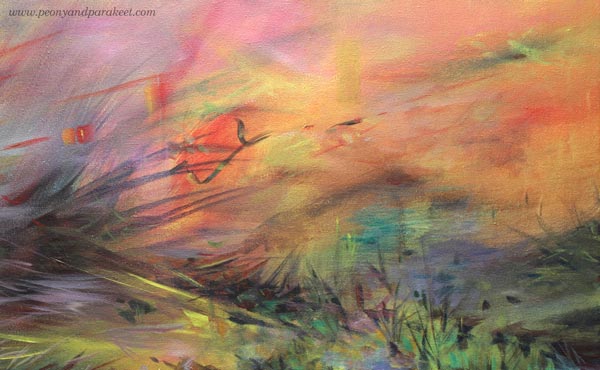
If grief smoked, we would all be covered in it. Even if it’s the saddest thing, it’s also beautiful to let go of someone or something you love. You can no longer help them, and it’s time to give them away.
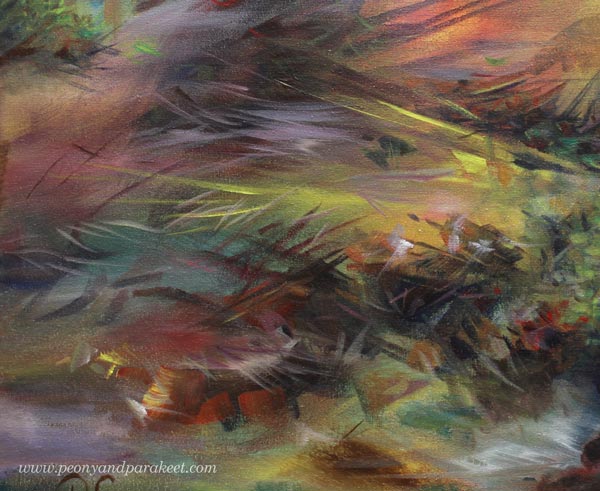
Mental Queue – Images That Need to Get Painted
Art helps us with things that can’t be solved intellectually. I also think that artists have a mental queue. If we try to jump over the hard images, we don’t have the energy for the more cheerful ones that come next.
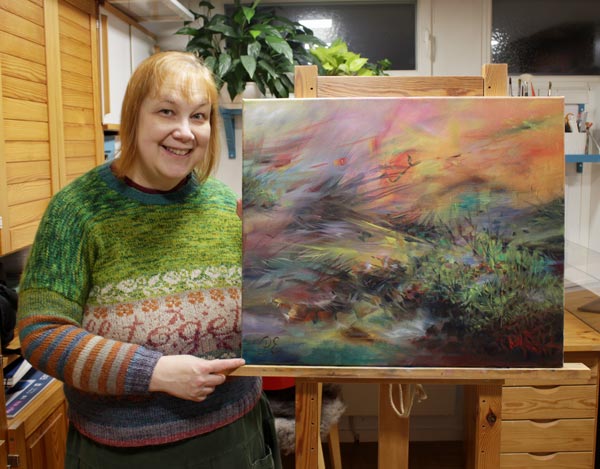
I hope this inspires you to pick the brush and paint the image that has been waiting for its turn.